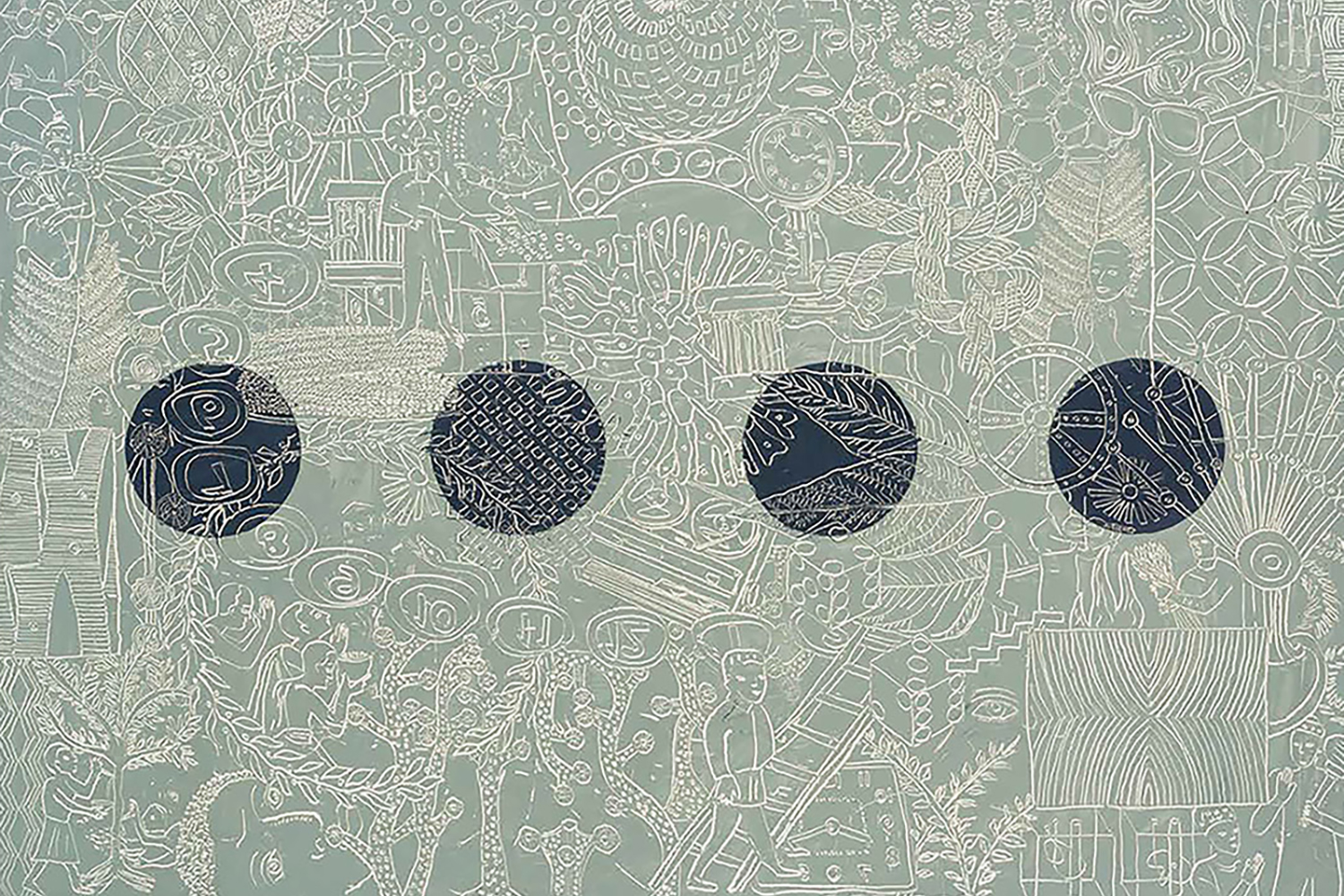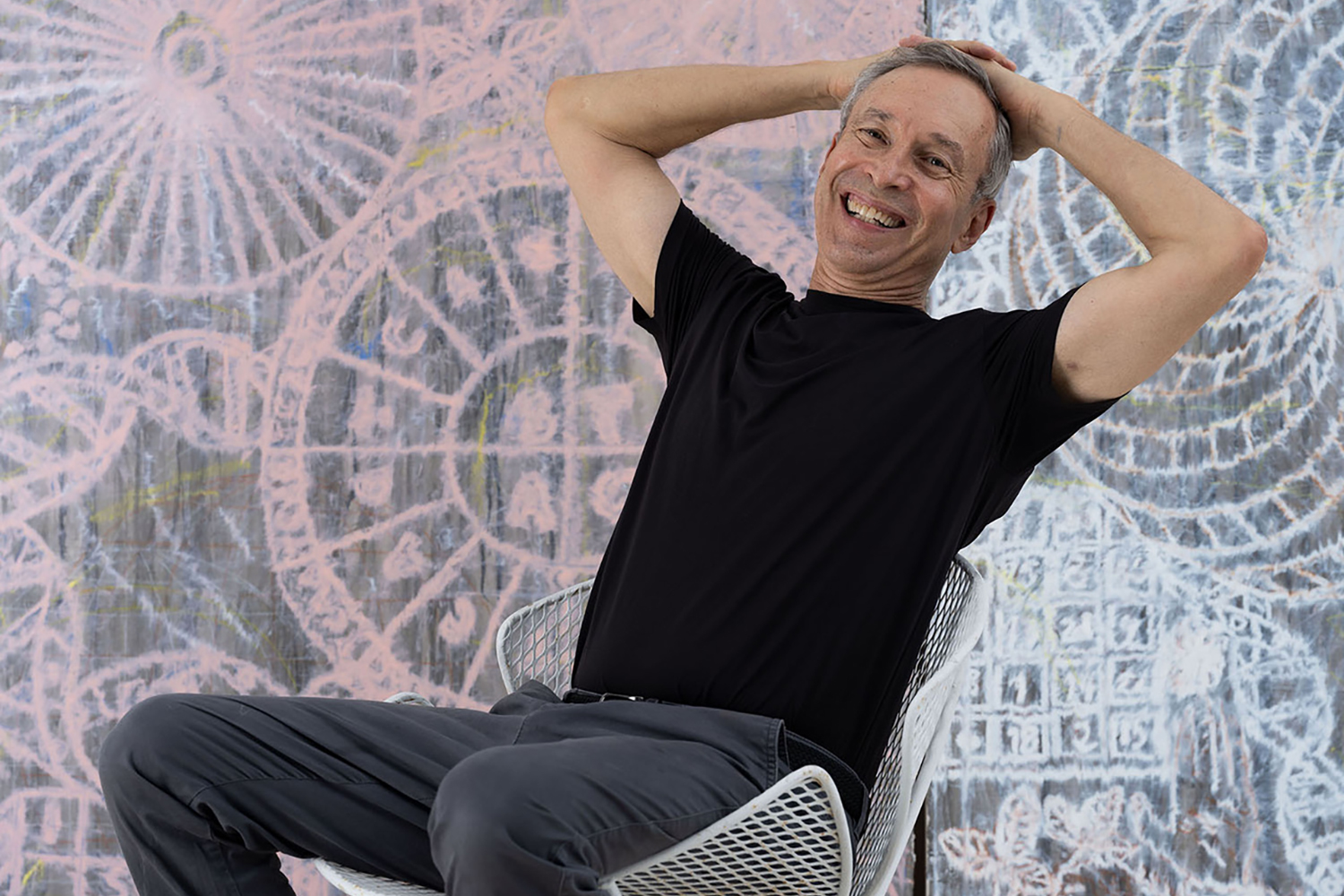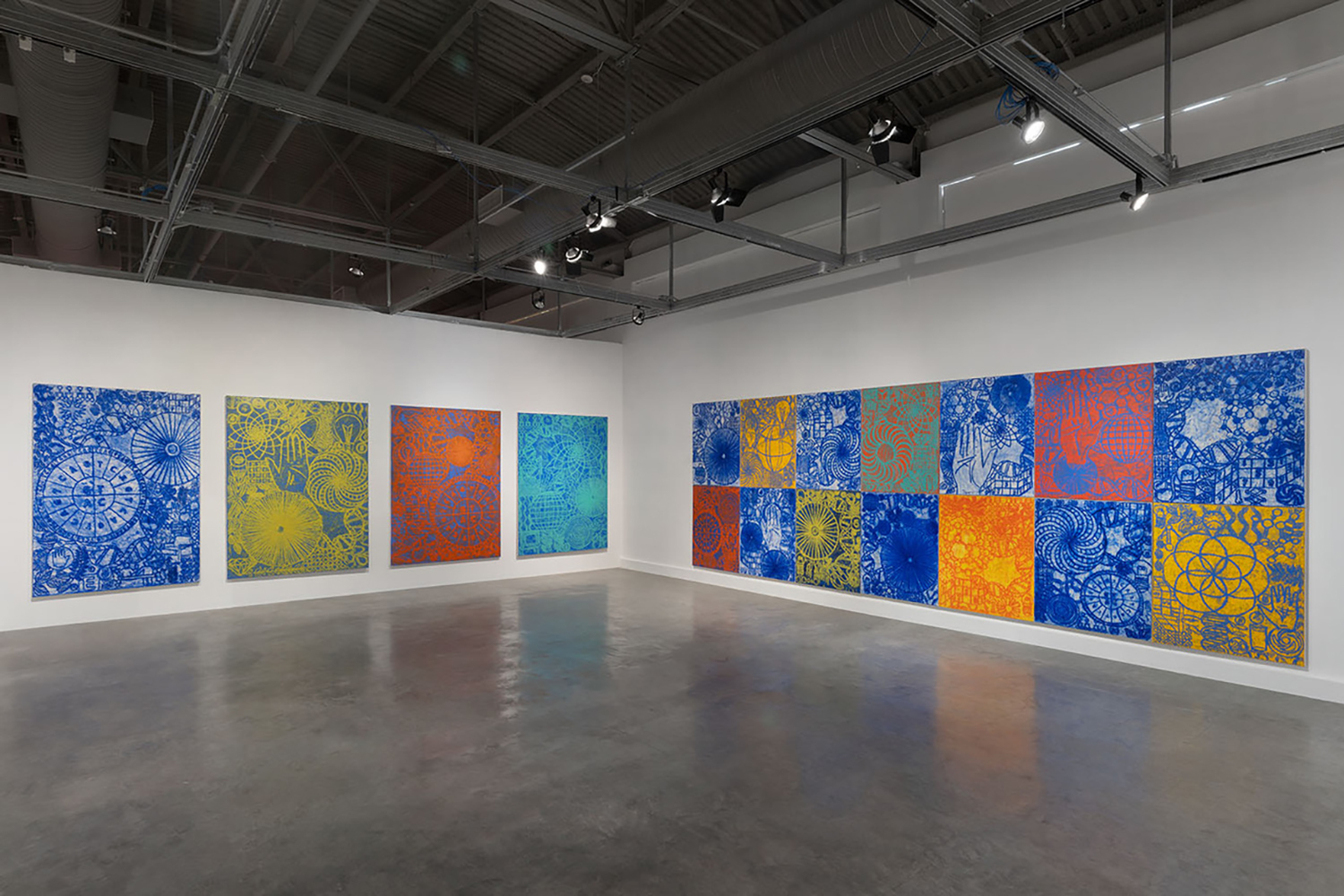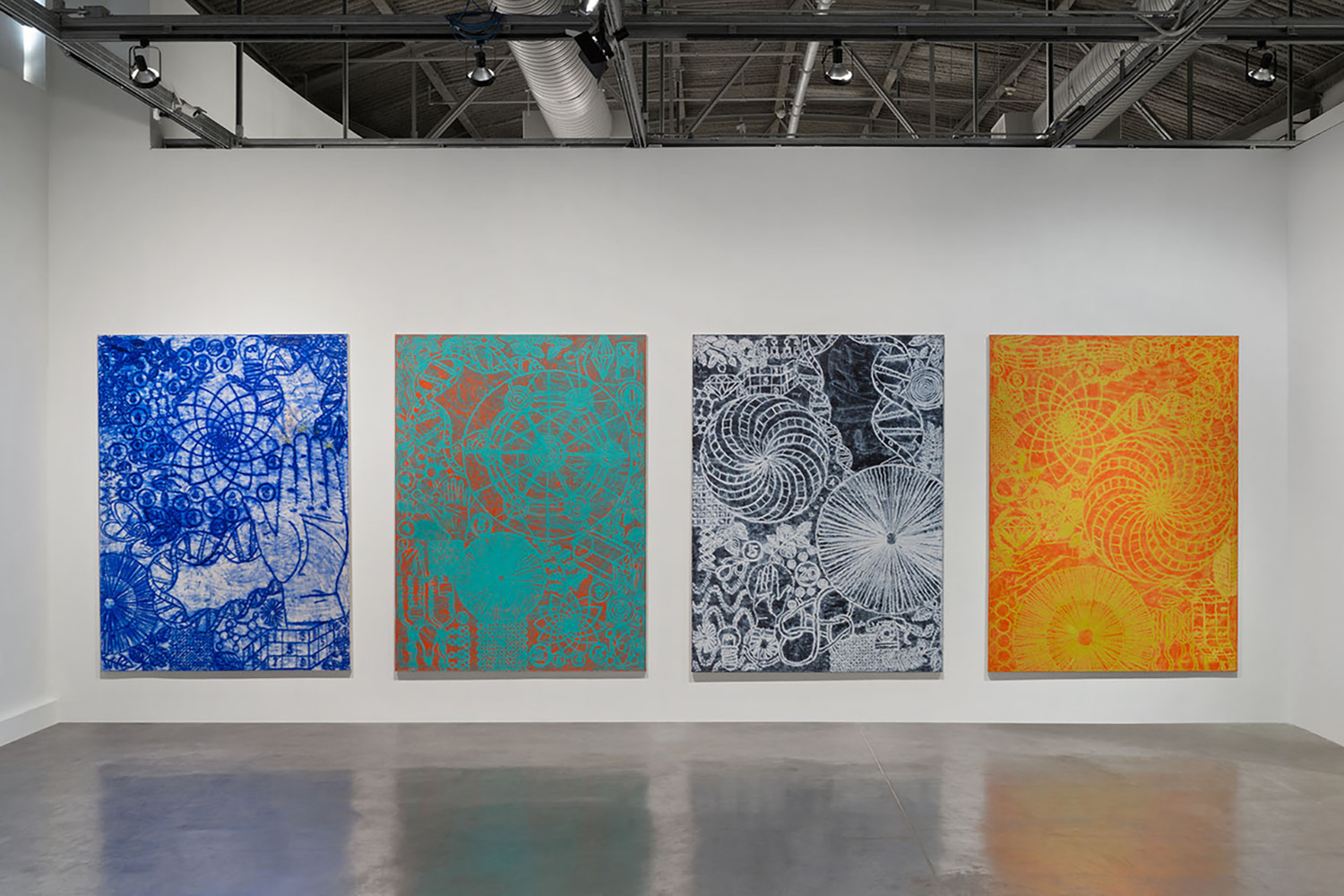
"Four Portals," Philip Smith. (Photo by Oiol Tarridas)
Standing in front of work by artist Philip Smith is an experience not unlike beginning a long book, a page turner that continues opening chapter after chapter. Gallery visitors teeter on the brink of knowledge Smith has gleaned from an extensive and industrious career. “Alice” has nothing on Smith’s journey through the looking glass.
Peering deeper, sub-chapters whisper more secrets to be revealed if you allow the art to take you higher, into the complexities of existence.
Smith is a Miami artist, born and raised, though he’s maintained New York City as a second base through many decades. Keeping a studio in the quiet, still rural neighborhood of his Miami childhood, this artist continues the thread of his personal odyssey.
Always where he needs to be, Smith is a deceptively low-key dude on the surface with a back story that is not like any you might recognize . . . but want to.
For this 2025 spring/summer/fall exhibition, MoCA, North Miami has recognized one of South Florida’s gems, honoring a fifty-year retrospective of a trip that began earnestly in the 1970s when Smith joined a fresh world inhabited by ideas of a new creative direction in a rapidly changing society.

Portrait of Philip Smith. (Photo by Oiol Tarridas)
Technology was on the brink of taking the reins; the 60s and 70s got busy throwing down pavement to lead us forward. Smith headed to New York as a young man, becoming one of the the originals in a 1970s movement called the "Pictures Generation."
I spoke with him about the early years. Smith became involved in the Pictures Generation when his work “checked all the boxes” of an exhibition formed by a curator focusing on the innovative quest for a different imagery.
“The Pictures Generation was a more literate culture," says Smith. "Pre-digital, all picture artists were anticipating that images were going to cut free and could mean anything, and be manipulated and interpreted, long before Photoshop.”
He continues: “I’d find images I liked and photograph them, then develop and use the film as my image library, which was not how other artists were working.”
As society moved away from traditional art practices to the beginnings of a more technical world innovative, Smith continued to utilize drawing and photography in his work throughout the years, highlighted at the MoCA retrospective. Tracing pictures with paint and wax, often scratching through layers, easing out linear imagery, he often reflected the old Italian technique of sgraffito, based on the word graffiare meaning “to scratch.”
Philip Smith found his way into the clutch of what was imaginative and exciting at that time. Andy Warhol could be termed the original modern social media influencer. He used portraiture of the rich, famous and influential . . . main interests which resonated with the young and the restless of Warhol’s early years. (“The more things change, the more they stay the same…” writes Jean-Baptiste Alphonse Karr).
Smith was there. He wrote for Warhol’s Interview magazine. Warhol was a pop star who constantly photographed. Clunky 35mm cameras were in place of our pocket-sized toys of the now . . . pictures then needed to be laboriously developed in a multi-equipment dark room set-up. Quickly posting out to the world with a one-finger tap, the mass of recent influencers can create “product” in a flash as they stand on the sidewalk, a mushroom latte in hand.

Installation view of Philip Smith "Magnetic Fields," which features more than 50 works created over five decades at MOCA, North Miami. (Photo by Zachery Balber Photography)
Guest curator at MoCA for "Magnetic Fields," Robin Clark eloquently takes viewers through Smith’s trek through time, space and energy, helping us divine how one artist’s life bloomed as he traversed the decades. Clark has a pedigree that offers a wealth of information swept up from stints as Scholar-in-Residence in the Gender and Women’s Studies Department at the University of California, Berkeley, participating in an interdisciplinary research grant focused on aspects of the permanent collection at the San Francisco Museum of Modern Art, toss in curator of “The Light Project” at the Pulitzer Foundation for the Arts, and you get that Clark knows how to dig out the nugget of an exhibition.
From Smith’s early career of oil pastel drawings on paper, Smith’s art morphed to using a canvas substrata, with paint and wax adding to drawings.
As I contemplated each piece (the latest being his inky blue energy paintings of this decade), I was drawn to ponder the presence of information just out of reach. If I concentrated more intently, I might access clarity that I hold in a deeper recess of knowledge, the consciousness of the subconscious, I suppose.
This work makes visiting an exhibition worthwhile. Step out of the bright sunshine for a minute and enter Smith’s mind. It will give you something better to think about when you wake up at 3 a.m. with a brain awash in busy-ness and useless fears.
Smith has been traversing the planet long enough to sort out a few thoughts, his chosen method of communication is through the ideas and iconography of other worlds, piggy-backing onto the deeper thinking of those who came before him; those inhabiting other cultures, science, math, and yes, even other realms.
Smith on Smith
“There is a very comprehensive narrative here,” (referring to the MoCA exhibition). “And it all makes sense. In some retrospectives, each room bleeds into another, but each of these (rooms) are all very, very distinct experiences.”
The exhibition is available in his publication “Philip Smith: Magnetic Fields,” available in MoCA’s gift shop along with his first book “Walking Through Walls.”
Speaking of page turners, Smith’s 2008 memoir "Walking Through Walls" opens up the subject of how Smith began. You thought we were done here, didn’t you. Oh no, no, no.

"Philip Smith: Magnetic Fields" is the first career survey of painter Philip Smith (American, born Miami, 1952). (Photo by Zachery Balber Photography)
His father, Lew, was a big deal Interior Designer in the 1950s and 1960s around Miami’s high scenic profile. After Lew discovered a mind-bending hidden talent, he moonlighted as a psychic healer, augmented by communicating with the dead.
Lew eventually gave up a lucrative interior design career to cure thousands of people. Imagine being in your high school years with that chronically mortified gene that’s built into every teen regarding aberrant parental behavior. I’m not surprised Philip adopted a low key personae with Lew hanging a pendulum over the melons in Publix to check for ripeness.
Lew had a following that regularly lined up around the block of their house, as his reputation as a real deal healer got around. He eventually trained his son in these healing methods, but Philip had his own road in the arts to plow, albeit en route to some similar conclusions.
“Walking Through Walls” is not only one artist’s fascinating memoir, but a deep dive into an historic Miami of the Modernism era; from design trends, food choices to how Miami spun through it’s days.
What is obvious in the telling of his childhood is that Smith had a leg up on coloring outside the lines.
I didn’t know all of the iconic referencing in the paintings placed throughout MoCA’s spaces, but I could traverse the years of a painting as it tells a distinct tale of each new decade in Smith’s life: medical references pepper days with his father, juxtaposed with a panel featuring a 1950s toaster, apron, rotisserie food, all intertwined with a double helix snaking its way through the copious imagery of each piece, canvases growing larger as time moves on.
I’m stumped at the deeper meaning of some icons, clearer on others: bees, numbers, a magnifying glass, modern lamps on dressers, ancient ruins, calendar pages, clocks stuck on 10:10, a can of corned beef. Each picture feels like a long, deep conversation through the ages.
As I stare at one specific canvas, I am aware of seeing earth from far away, then the sensation of suddenly zooming into the depth of what makes us tick; but hold on . . . Smith continues to keep us zooming in closer and closer, taking a magnifying glass to our daily existence.
Art is not what you see, but what you make others see.”- Edgar Degas
Make sure to see MoCA’s second exhibition. It’s worth a spin.
Also, on display, "Vickie Pierre: The Maiden is The Warrior." "Her artistic practice is a vivid exploration of memory, transformation, and identity, rooted in her Haitian heritage and the material culture that surrounds her."
The Museum of Contemporary Art
770 NE 125th St, North Miami 33161
(305) 893-6211 | www.mocanomi.org
Current exhibitions continue through Sunday, Oct. 5
 MAIN MENU
MAIN MENU

